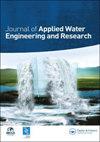用计算流体力学方法模拟纵向桥梁串联桥墩周围的超剪应力
IF 1.6
Q4 WATER RESOURCES
Journal of Applied Water Engineering and Research
Pub Date : 2021-03-04
DOI:10.1080/23249676.2021.1884614
引用次数: 2
摘要
基于计算流体力学(CFD)对纵桥串联桥墩周围的超剪应力进行了研究。以单墩过剪应力为参考,分析了串列墩的过剪应力分布。将单墩后过大剪应场划分为三个区域:旋涡区(0 ~ 16.5D,其中D为墩直径)、恢复区(16.5 ~ 35.5D)和稳定区(大于35.5D)。如果下游桥墩位于涡区,则由于Kármán涡街的堆积而产生遮蔽作用。这减少了桥墩之间的多余剪应力。如果下游桥墩位于恢复区内,则避风效果减弱。当下游桥墩位于稳定区内时,隔振效应不显著,各桥墩周围的超剪应力场趋于独立。本文章由计算机程序翻译,如有差异,请以英文原文为准。
Modeling excess shear stress around tandem piers of the longitudinal bridge by computational fluid dynamics
This study investigates the excess shear stress field around tandem piers of longitudinal bridge based on Computational Fluid Dynamics (CFD). The excessive shear stress field of the single pier is used as a reference to analyze the excessive stress distribution of tandem piers. The excessive shear stress field behind a single pier is divided into three areas: vortex area (0–16.5D, where D is the diameter of the pier), recovery area (16.5D to 35.5D), and stable area (longer than 35.5D). If the downstream piers are located in the vortex areas, sheltering effects occur due to the accumulation of Kármán vortex streets. This reduces the excess shear stress between piers. If the downstream piers are located in the recovery areas, sheltering effects decrease. If the downstream piers are located in the stable areas, the sheltering effects is insignificant and the excess shear stress field around each pier becomes independent.
求助全文
通过发布文献求助,成功后即可免费获取论文全文。
去求助
来源期刊

Journal of Applied Water Engineering and Research
WATER RESOURCES-
CiteScore
2.90
自引率
16.70%
发文量
31
期刊介绍:
JAWER’s paradigm-changing (online only) articles provide directly applicable solutions to water engineering problems within the whole hydrosphere (rivers, lakes groundwater, estuaries, coastal and marine waters) covering areas such as: integrated water resources management and catchment hydraulics hydraulic machinery and structures hydraulics applied to water supply, treatment and drainage systems (including outfalls) water quality, security and governance in an engineering context environmental monitoring maritime hydraulics ecohydraulics flood risk modelling and management water related hazards desalination and re-use.
 求助内容:
求助内容: 应助结果提醒方式:
应助结果提醒方式:


